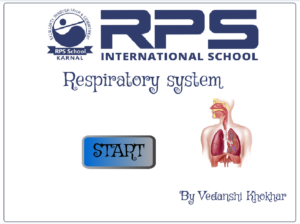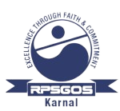RPS Coding Club Karnal
Subject Integrated Coding Program

Respiratory System
What is the respiratory system?
The respiratory system is the network of organs and tissues that help you breathe. It includes your airways, lungs and blood vessels. The muscles that power your lungs are also part of the respiratory system. These parts work together to move oxygen throughout the body and clean out waste gases like carbon dioxide.
What does the respiratory system do?
The respiratory system has many functions. Besides helping you inhale (breathe in) and exhale (breathe out), it:
- Allows you to talk and to smell.
- Warms air to match your body temperature and moisturizes it to the humidity level your body needs.
- Delivers oxygen to the cells in your body.
- Removes waste gases, including carbon dioxide, from the body when you exhale.
- Protects your airways from harmful substances and irritants.
What are the parts of the respiratory system?
The respiratory system has many different parts that work together to help you breathe. Each group of parts has many separate components.
Your airways deliver air to your lungs. Your airways are a complicated system that includes your:
- Mouth and nose: Openings that pull air from outside your body into your respiratory system.
- Sinuses: Hollow areas between the bones in your head that help regulate the temperature and humidity of the air you inhale.
- Pharynx (throat): Tube that delivers air from your mouth and nose to the trachea (windpipe).
- Trachea: Passage connecting your throat and lungs.
- Bronchial tubes: Tubes at the bottom of your windpipe that connect into each lung.
- Lungs: Two organs that remove oxygen from the air and pass it into your blood.
From your lungs, your bloodstream delivers oxygen to all your organs and other tissues.
Muscles and bones help move the air you inhale into and out of your lungs. Some of the bones and muscles in the respiratory system include your:
- Diaphragm: Muscle that helps your lungs pull in air and push it out.
- Ribs: Bones that surround and protect your lungs and heart.
When you breathe out, your blood carries carbon dioxide and other waste out of the body. Other components that work with the lungs and blood vessels include:
- Alveoli: Tiny air sacs in the lungs where the exchange of oxygen and carbon dioxide takes place.
- Bronchioles: Small branches of the bronchial tubes that lead to the alveoli.
- Capillaries: Blood vessels in the alveoli walls that move oxygen and carbon dioxide.
- Lung lobes: Sections of the lungs — three lobes in the right lung and two in the left lung.
- Pleura: Thin sacs that surround each lung lobe and separate your lungs from the chest wall.
Some of the other components of your respiratory system include:
- Cilia: Tiny hairs that move in a wave-like motion to filter dust and other irritants out of your airways.
- Epiglottis: Tissue flap at the entrance to the trachea that closes when you swallow to keep food and liquids out of your airway.
- Larynx (voice box): Hollow organ that allows you to talk and make sounds when air moves in and out.
